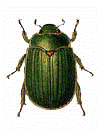Museum, University of Nebraska State
Date of this Version
5-1980
Abstract
Although rocks of floodplain origin are volumetrically important, they contain relatively few trace fossils; both abundance and diversity are low. Conversely, Holocene floodplain sediments locally contain abundant and diverse lebensspuren mostly produced by insects, spiders, nematodes, annelids and molluscs. At least 8 insect orders and 31 families include species that burrow in floodplain sediments and yet none of their lebensspuren are unique to this environment. Taxonomically dissimilar insects produce morphologically similar lebensspuren, and the same species, or individual, may produce very dissimilar lebensspuren. Thus, identification of tracemakers for rocks of floodplain origin is as difficult as for marine rocks. Trace fossil form genera morphologically similar to Holocene floodplain lebensspuren include Skolithos, Cylindricum, Sabellarifex, Macanopsis, Planolites, Palaeophycus, Sinusites, Cochlichnus, Amphorichnus and possibly also Scolicia; many previous authors have regarded these as more typical of marine environments than of floodplains.


Comments
Published in JOURNAL OF PALEONTOLOGY 54:3 (May 1980), pp. 614-630. Copyright 1980 The Society of Economic Paleontologists and Mineralogists